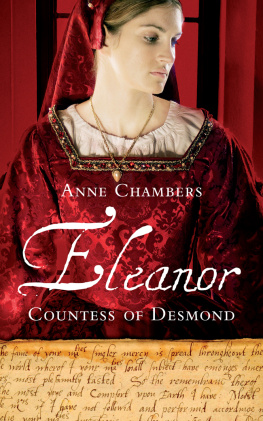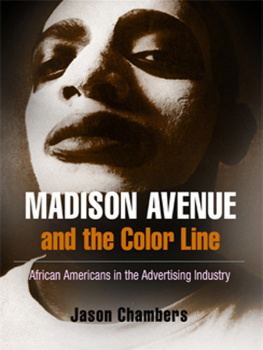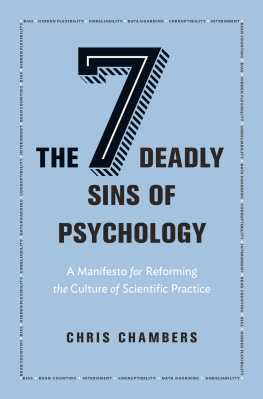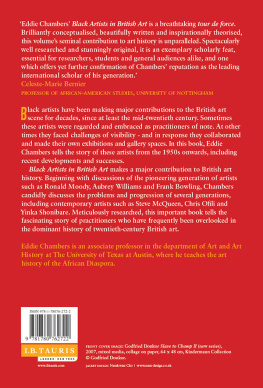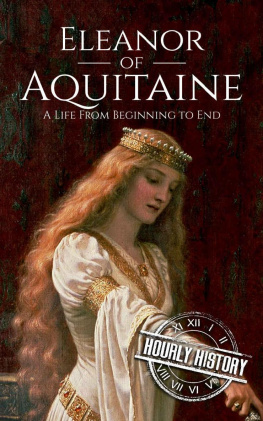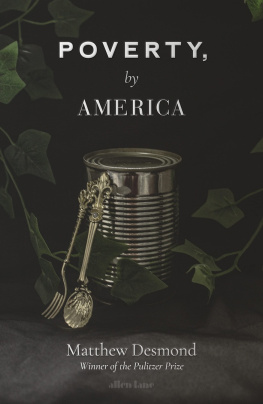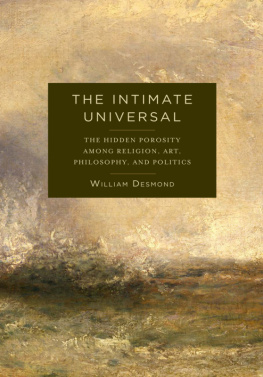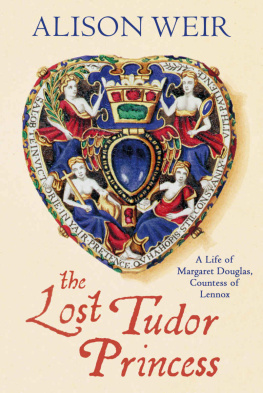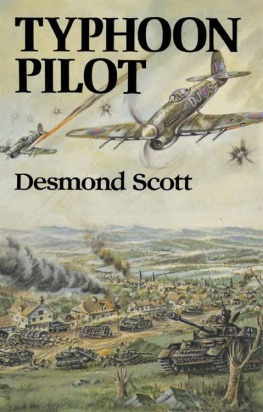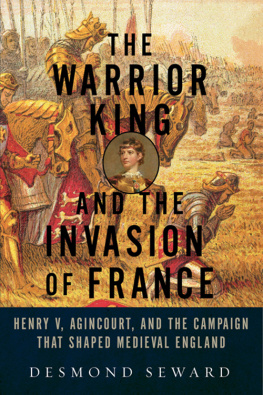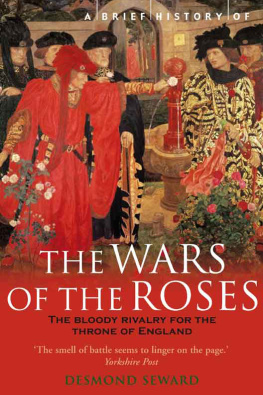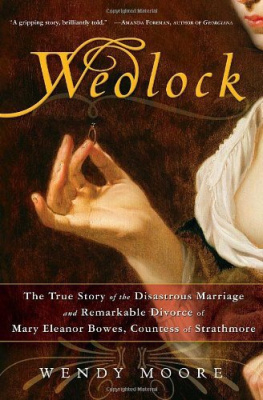Eleanor,
Countess of Desmond
Anne Chambers
Gill & Macmillan
Contents
Chronology
1545Eleanor born at Kiltinan castle
1547Death of Henry VIII
1558Accession of Elizabeth I
1558Gerald FitzGerald becomes fourteenth Earl of Desmond
1565Eleanor marries Gerald
1565Battle of Affane
1565Gerald taken prisoner to England
1565Sir Henry Sidney appointed Lord Deputy
1565Gerald returns from captivity
1566Birth of Eleanors first daughter
1567Gerald imprisoned in Dublin Castle
1567Gerald and Sir John sent to the Tower
1568Eleanor administers the Desmond estates
1569First Desmond Rebellion
1570Eleanor in Tower of London
1570Eleanor and Gerald under restraint in Kent
1570Sir John Perrot, President of Munster
1570Excommunication of Elizabeth I
1571Birth of Eleanors son, James, in London
1572St Bartholomews Day Massacre, Paris
1573Eleanor and Gerald granted audience with Elizabeth I
1573Eleanor and Gerald return to Ireland
1573Gerald detained in Dublin
1573Gerald escapes to Munster
1573Eleanor and Gerald welcomed at Lough Gur
1574Gerald re-captures Castlemaine and Castlemartyr
1574Meeting of Eleanor and Gerald with Earl of Essex at Waterford
1574Signing of Combination Document
1574Ormond destroys Derrinlaur Castle
1575Eleanor writes to Queen Elizabeth
1575James FitzMaurice departs for St Malo
1575Eleanor seeks the return of her son
1575Sidney re-appointed Lord Deputy
1576Sir William Drury appointed President of Munster
1577Eleanor intervenes with Drury
1577Eleanor and Gerald take refuge in Kerry
1578Tentative peace accord with Drury
1578Eleanor and Gerald bid farewell to Sidney in Dublin
1578Eleanor sends Elizabeth a gift of marten skins
1579Eleanor re-united with her son
1579FitzMaurice and Papal Force land at Smerwick Harbour
1579Second Desmond Rebellion
1579Murder of Davells and Carter
1579Death of James FitzMaurice
1579Eleanor entrusts her son to Drury
1579Askeaton Abbey desecrated by Sir Nicholas Malby
1579William Pelham, Lord Justice
1579Eleanor intercedes with Pelham
1579Earl of Desmond proclaimed traitor
1579Third Desmond Rebellion
1580Eleanor thwarted in her efforts to go to Queen Elizabeth
1580Gerald sacks Youghal
1580Destruction of Carraigafoyle and Askeaton
1580Eleanor and Gerald on the run in Munster
1580Eleanor entrusts her daughters to her sisters
1580Pelham and Ormond combine against the Desmond forces
1580Eleanor and Gerald hunted by English
1580Winter delivers Eleanors letter to Court
1580Execution of Sir James Fitzgerald at Cork
1580Sir Arthur Grey de Wilton, Lord Deputy
1580Massacre of Spanish at Dn-an-ir
1581Death of Dr Sanders
1582Death of Sir John of Desmond
1582Eleanor intercedes with Grey at Maryborough
1582Eleanor rejoins Gerald on the run
1583Ormond leads the final push against Gerald
1583Gerald tries to negotiate
1583Eleanor and Gerald part
1583Eleanor submits to Ormond
1583Gerald killed near Tralee
1584Sir John Perrot, Lord Deputy
1584Eleanor and her daughters in Dublin Castle
1584Eleanors son sent to the Tower of London
1585Formal attainder of Desmond estate
1585Eleanor attempts to salvage part of estate
1586Eleanor and her daughters reduced to penury
1587Eleanor petitions Elizabeth
1588Eleanor makes her way to the English Court
1588Spanish Armada
1588Eleanor received by Elizabeth in St Jamess Palace
1588Elizabeth authorises pardon and pension for Eleanor and her daughters
1588Eleanor visits her son in the Tower. Petitions the Queen for further support
1592Red Hugh ODonnell escapes from Dublin Castle
1595Hugh ONeill and ODonnell conspire with Spain
1597Eleanor marries Sir Donogh OConnor Sligo
1597Eleanor and Donogh settle in Collooney Castle
1597Sir Conyers Clifford, President of Connaught
1597Battle of the Yellow Ford
1597Earl of Essex, Lord Deputy
1599Siege of Collooney Castle by ODonnell
1599Battle of Curlew Mountains
1599Donogh submits to ODonnell
1600Lord Mountjoy, Lord Deputy
1600Return of Eleanors son to Munster
1601Death of Eleanors son in Tower of London
1601Battle of Kinsale
1603Death of Elizabeth I
1603Eleanor at Court of James I
1603Assistance from Robert Cecil
1607Eleanor and Donogh in legal battles with new colonists
1609Death of Sir Donogh OConnor Sligo
1613Eleanor wins legal battle for possession of Sligo estate
1619Desmond title bestowed on Sir Richard Preston and subsequently on the Earl of Denbigh
1638Eleanors will and death
Prologue
Out of every corner of the woods and glens they
came creeping forth upon their hands for their
legs could not bear them, they looked like
anatomies of death, they spoke like ghosts, crying
out of their graves, they did eat the dead carrions,
happy where they could find them, yea, and one
another soon after, insomuch as the very carcasses
they spared not to scrape out of their graves and if
they found a plot of watercresses or shamrocks,
there they flocked as to a feast for a time, yet not
able long to continue there withal, that in short
space there were none almost left, and a most
populous and plentiful country suddenly left void
of man or beast.
EDMUND SPENSER
Edmund Spensers horrific account of starvation, cannibalism and decay described the state of the most fertile province of Ireland in 1582. The celebrated poet and civil servant bore witness to the dreadful spectacle that appalled his eyes and compelled his stern Elizabethan heart to cry out in pity.
A once rich province, the size of modern Holland, Munster lay devastated. Lush green pasturelands were torched to a blackened heath, devoid of crops or animals. Famine stalked rampant through the vales and over the gently sloping hills. Among the smouldering remains the skeletal figures of the surviving peasantry foraged in vain. The castles and keeps of the local aristocracy lay in ruins, open to the unrelenting icy rain that hissed in vengeance on the smoking embers. The people were scattered and hid like wild beasts in the fortresses of Munsters rugged mountain ranges and in her great, dark forests andwild glens. They peered silently through the bare branches and waited. They awaited the return of the great overlord their master to whom, by tradition as ancient as the vast oak forests that sheltered them, they had given their absolute allegiance. They waited for him to lead them once more into battle in the bloody and futile war that for over three years had raged and ravaged the countryside.
But the great overlord shared the same fate as his clansmen. Askeaton castle, the mighty pile on the banks of the River Deel, the symbol of his familys once proud and powerful heritage, lay in ruins. A company of English horse was stabled in its great banqueting hall. Its lord was hunted like a wild animal over the despoiled estates of his Munster lordship. From the lowly wattle huts of his kern, from cold mountain caves to the ruined fortresses of his ancestors, through the marshy recesses of the Glen of Aherlow, into the dark forest of Kylemore and across the tortuous mountain passes to the west, Garrett FitzGerald, the fourteenth earl of the ancient and noble House of Desmond, fled for his life.
He had many impediments in his headlong flight. His once populous army had vanished, decimated more by famine and fear than by actual engagement with the enemy. His erstwhile allies had, one by one, forsaken him. Every friend had become a potential foe as the price on his head increased. His inheritance of over a half million acres of land in Munster provided the incentive and the scent to the eager English greyhounds who leaped from the slips in pursuit. But perhaps the greatest impediment to his safety stemmed from his own physical disabilities. His body had succumbed to the effects of palsy and the Irish ague, the result of lengthy periods of imprisonment and deprivation, aggravated by the dampness that oozed up from the marshes and bogs and by the rain that dripped incessantly from the bushes and undergrowth in which he hid, or from the sodden thatch of the kerns cabins when he managed a fitful nights respite from the elements and the enemy. Yet despite these overwhelming liabilities, the earl had one remaining assethis countess, Eleanor.

